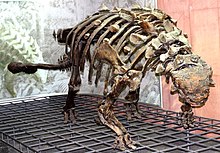Euoplocephalus
| Euoplocephalus | |
|---|---|

| |
| Esqueleto do espécime ROM 1930 no Museu de História Natural Senckenberg | |
| Classificação científica | |
| Domínio: | Eukaryota |
| Reino: | Animalia |
| Filo: | Chordata |
| Clado: | Dinosauria |
| Clado: | †Ornithischia |
| Clado: | †Thyreophora |
| Subordem: | †Ankylosauria |
| Família: | †Ankylosauridae |
| Subfamília: | †Ankylosaurinae |
| Tribo: | †Ankylosaurini |
| Gênero: | †Euoplocephalus Lambe, 1910 |
| Espécie-tipo | |
| †Stereocephalus tutus Lambe, 1902
| |
| Espécies | |
| |
Euoplocephalus (Euoplocephalus tutus, do latim "cabeça bem protegida") foi um género de dinossauro herbívoro, semelhante ao anquilossauro, que viveu no final do período Cretáceo. Este anquilossaurídeo pesava cerca de 2 a 4 toneladas (equivalente a 1 hipopótamo) e media até 6 metros de comprimento.[1] A espécie-tipo foi denominada Stereocephalus tutus em 1902 por Lawrence Lambe, sendo alterado para Euoplocephalus tutus em 1910.[2]
O corpo era protegido por uma armadura óssea dotada de calombos e espinhos (os maiores se situavam praticamente no começo de sua extensa carapaça) e tinha uma cauda que terminava numa maça óssea parecida com um martelo, de função defensiva, que graças a músculos bem rígidos da cauda era balançada a fim de acertar um ponto vulnerável de um predador, tal como uma bola de demolição. A sua cabeça possuía também uma carapaça rígida, sendo que em cada face o animal possuía um par de espinhos situados um em cima do outro (fato característico dos animais de sua família).[3]
Ver também
[editar | editar código-fonte]Referências
- ↑ A NEW METHOD TO CALCULATE ALLOMETRIC LENGTH-MASS RELATIONSHIPS OF DINOSAURS https://bioone.org/journals/journal-of-vertebrate-paleontology/volume-21/issue-1/0272-4634(2001)021
- ↑ L. M. Lambe (1910). «"Note on the parietal crest of Centrosaurus apertus and a proposed new generic name for Stereocephalus tutus".». The Ottawa Naturalist. 24. pp. 149–51
- ↑ K Carpenter (1982). «"Skeletal and dermal armor reconstruction of Euoplocephalus tutus (Ornithischia: Ankylosauridae) from the Late Cretaceous Oldman Formation of Alberta». Canadian Journal of Earth Sciences. 19 (4): 689–97. Bibcode:1982CaJES..19..689C. doi:10.1139/e82-058
Text is available under the CC BY-SA 4.0 license; additional terms may apply.
Images, videos and audio are available under their respective licenses.


